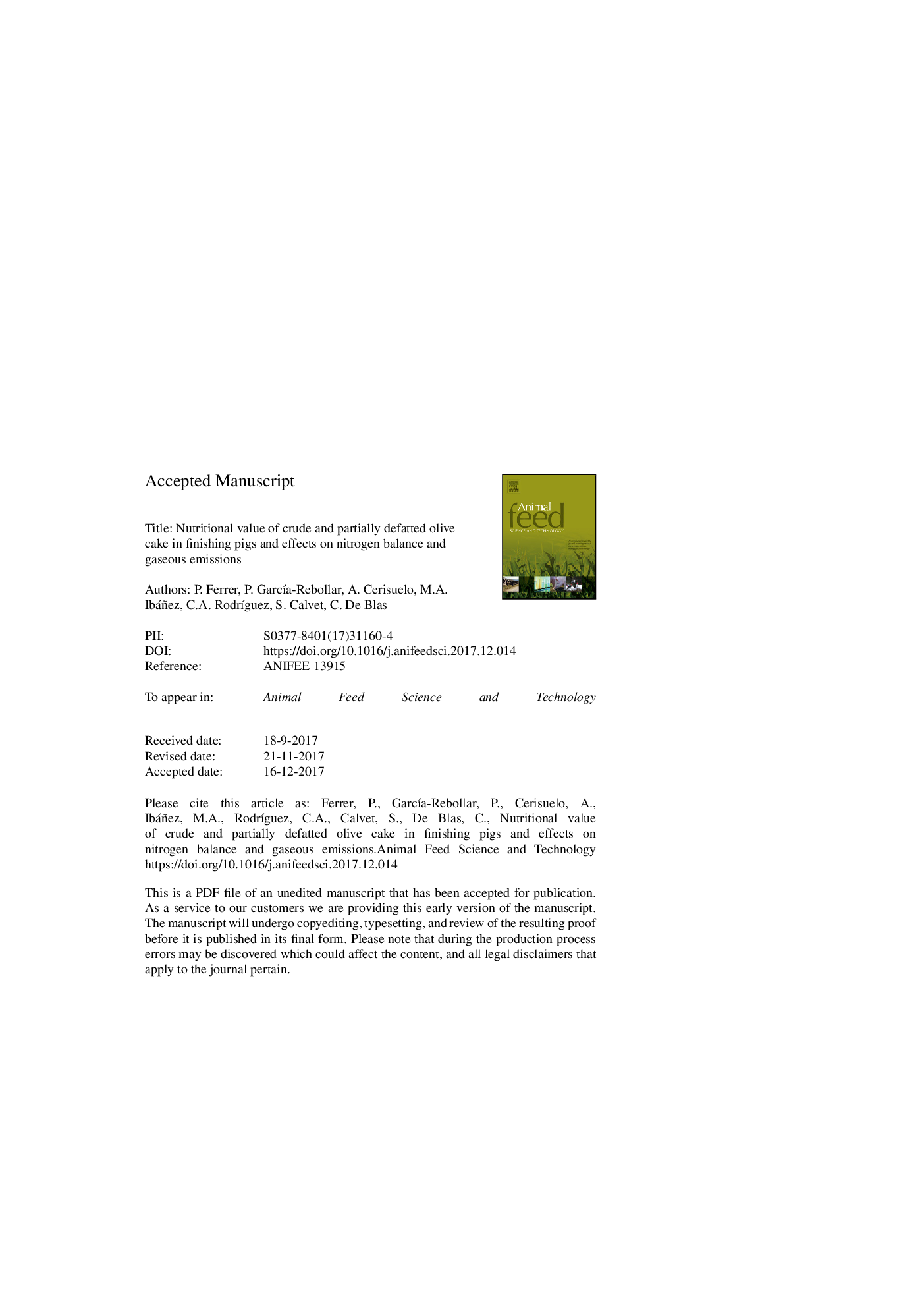| کد مقاله | کد نشریه | سال انتشار | مقاله انگلیسی | نسخه تمام متن |
|---|---|---|---|---|
| 8491051 | 1552350 | 2018 | 31 صفحه PDF | دانلود رایگان |
عنوان انگلیسی مقاله ISI
Nutritional value of crude and partially defatted olive cake in finishing pigs and effects on nitrogen balance and gaseous emissions
ترجمه فارسی عنوان
ارزش تغذیه ای از کیک زیتون خام و نیمه خشک در تکمیل خوک ها و اثرات آن بر تعادل نیتروژن و انتشار گازهای گلخانه ای
دانلود مقاله + سفارش ترجمه
دانلود مقاله ISI انگلیسی
رایگان برای ایرانیان
کلمات کلیدی
AOACacid detergent insoluble CPNDICPADICPaNDFomCTTADCOCTKNTANADFomTDFNH3ADLVFACH4Ammonia - آمونیاکVolatile fatty acids - اسیدهای چرب فرارAmmonia emission - انتشار آمونیاکMethane emission - انتشار گاز مگنassociation of official analytical chemists - انجمن متخصصان تحلیلی رسمیDigestible energy - انرژی قابل هضمDigestion efficiency - بازده گوارشNitrogen balance - تعادل نیتروژنstandard error of means - خطای استاندارد معنیcoefficient of total tract apparent digestibility - ضریب هضم ظاهری کل دستگاهtotal dietary fibre - فیبر رژیمی کلacid detergent lignin - لیگنین پاک کننده اسیدorganic matter - ماده آلیdry matter - ماده خشکMethane - متان SEM - مدل معادلات ساختاری / میکروسکوپ الکترونی روبشیbiochemical methane potential - پتانسیل متان بیوشیمیاییcrude protein - پروتئین خامneutral detergent insoluble crude protein - پروتئین خام مواد نامطلوب خنثی خنثیtotal Kjeldahl nitrogen - کل نیتروژن Kjeldahltotal ammonia nitrogen - کل نیتروژن آمونیاکOlive cake - کیک زیتون
موضوعات مرتبط
علوم زیستی و بیوفناوری
علوم کشاورزی و بیولوژیک
علوم دامی و جانورشناسی
چکیده انگلیسی
By-products from the food industry can be valuable ingredients in animal feeds. One example is olive cake (OC), generated in large amounts by the olive oil industry, which contains oil with a high proportion of oleic acid and polyphenols. An experiment was performed using pigs to determine the nutritional value of crude (COC) and partially defatted (PDOC) olive cake, and to evaluate their effect on nutrient balance, slurry properties and potential ammonia (NH3) and methane (CH4) emissions. Five experimental feeds were designed; a basal diet and another four diets produced by substituting 100 or 200â¯g/kg of the basal diet with either COC or PDOC. Thirty finishing male pigs (76.1â¯Â±â¯4.2â¯kg initial BW) were used in the experiment (6 animals/treatment). After a 14-day adaptation period, faeces and urine were collected separately for 7â¯days to measure nutrient digestibility and the excretory patterns of nitrogen. Potential NH3 and CH4 emissions were measured in reconstituted slurry samples over 11 and 100â¯days, respectively. The dry matter (DM), crude protein (CP), cellulose, starch and energy coefficients of total tract apparent digestibility (CTTAD) were negative and linearly (P <â¯0.05) affected by OC inclusion level. However, the type of OC did not influence any of the digestion efficiencies studied. The energy digestibility of the ingredients tested, estimated by substitution, were 0.479 (±0.040, SEM) and 0.327 (±0.049) for COC and PDOC, respectively. Overall, the results indicate a digestible energy (DE) value from COC and PDOC that account respectively for around 80 or 60% of the DE provided by barley grain in pigs. Faecal content of cellulose, polyphenols and gross energy (GE) increased linearly with OC inclusion, whereas ash content decreased. The total N content of urine decreased linearly with OC inclusion, but benzoic and hippuric acid contents increased, which resulted in lower pH values for the OC diets. The ratio between faecal and urine N excretion decreased from 2.48 in the basal diet to 1.01 on average in the 200â¯g/kg OC diets. As a result, increasing both COC and PDOC levels in diets resulted in lower NH3 emissions per volume of slurry and in a lower biochemical CH4 potential. Although slurry excretion increased with OC inclusion, daily NH3 emissions still decreased with increasing OC inclusion. However, potential CH4 emissions per animal increased. A global perspective throughout the production chain is needed to assess the impact of including OC in pig diets on gaseous emissions.
ناشر
Database: Elsevier - ScienceDirect (ساینس دایرکت)
Journal: Animal Feed Science and Technology - Volume 236, February 2018, Pages 131-140
Journal: Animal Feed Science and Technology - Volume 236, February 2018, Pages 131-140
نویسندگان
P. Ferrer, P. GarcÃa-Rebollar, A. Cerisuelo, M.A. Ibáñez, C.A. RodrÃguez, S. Calvet, C. De Blas,
